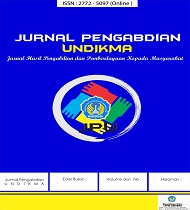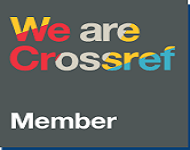Development of an Augmented Reality Book Based on Science Inquiry for Early Childhood
DOI:
https://doi.org/10.33394/jk.v10i4.12984Keywords:
Augmented Reality, Science Literacy, Early Childhood, Learning Media, Science Inquiry.Abstract
References
Afrianto, I., Faishal, A., & Atin, S. (2019). Hijaiyah letter interactive learning for mild mental retardation children using Gillingham method and augmented reality. International Journal of Advanced Computer Science and Applications, 10(6). https://doi.org/10.14569/ijacsa.2019.0100643
Asrial, A., Kurniawan, D., & Anandari, Q. (2020). Digitalization of ethno constructivism based module for elementary school students. Jurnal Ilmu Pendidikan, 25(1), 33. https://doi.org/10.17977/um048v25i1p33-42
Astini, B., Gunawan, G., & Sriwarthini, N. (2023). Analysis of scientific educational game tools implementation for early childhood students in west nusa tenggara. Jurnal Penelitian Pendidikan Ipa, 9(1), 427–432. https://doi.org/10.29303/jppipa.v9i1.2942
Atikah, C. (2023). Pengembangan media pembelajaran berbasis augmented reality pada tema binatang purba untuk meningkatkan kemampuan kognitif anak usia dini kelompok B (5-6) tahun di TK Tunas Insan Kamil Kota Serang. JEA (Jurnal Edukasi Aud), 9(2), 89–101. https://doi.org/10.18592/jea.v9i2.9326
Bhala, M. (2024). Penerapan media pohon literasi dalam meningkatkan minat baca sains siswa sd. Jurnal Ilmiah Pendidikan Citra Bakti, 11(2), 344–357. https://doi.org/10.38048/jipcb.v11i2.3299
Carroll, J., Holliman, A., Weir, F., & Baroody, A. (2018). Literacy interest, home literacy environment and emergent literacy skills in preschoolers. Journal of Research in Reading, 42(1), 150–161. https://doi.org/10.1111/1467-9817.12255
Chrismanto, A. (2024). Peran program kelas dalam membina literasi sains pada anak usia dini. Jurnal Mentari Manajemen Pendidikan Dan Teknologi Informasi, 2(2), 176–187. https://doi.org/10.33050/mentari.v2i2.490
Dewi, L., Jumini, S., & Adi, N. (2022). Implementasi media pohon literasi untuk meningkatkan literasi sains murid pada mata pelajaran ipa. Journal of Education and Teaching (Jet), 3(2), 247–267. https://doi.org/10.51454/jet.v3i2.190
DÜZYOL, E., YILDIRIM, G., & ÖZYILMAZ, G. (2022). Investigation of the effect of augmented reality application on preschool children’s knowledge of space. Journal of Educational Technology and Online Learning, 5(1), 190–203. https://doi.org/10.31681/jetol.976885
Eddy, C., & W., A. (2022). Rancang bangun aplikasi pembelajaran alat-alat optik berbasis augmented reality. Jurnal Informatika, 11(1), 98. https://doi.org/10.55340/jiu.v11i1.958
Ekhsan, H., Khairi, M., & Hamid, J. (2022). Enhancing sign language learning with augmented reality. Journal of Computing Research and Innovation, 7(1), 139–146. https://doi.org/10.24191/jcrinn.v7i1.277
Elsayed, S., & Al-Najrani, H. (2021). Effectiveness of augmented reality on improving the visual thinking in mathematics and academic motivation for middle school students. Eurasia Journal of Mathematics Science and Technology Education, 17(8), em1991. https://doi.org/10.29333/ejmste/11069
Faiza, M., Yani, M., & Suprijono, A. (2022). Efektivitas penggunaan media pembelajaran IPS berbasis augmented reality untuk meningkatkan kompetensi pengetahuan siswa. Jurnal Basicedu, 6(5), 8686–8694. https://doi.org/10.31004/basicedu.v6i5.3901
Febriani, N. (2023). Pengaruh model pembelajaran inkuiri dengan media realia terhadap literasi sains anak usia 4-5 tahun. Jieec (Journal of Islamic Education for Early Childhood), 5(2), 1. https://doi.org/10.30587/jieec.v5i2.5801
Firda, A., & Suharni, S. (2022). Tingkat kemampuan literasi sains guru pendidikan anak usia dini. Jurnal Obsesi Jurnal Pendidikan Anak Usia Dini, 6(5), 3868–3876. https://doi.org/10.31004/obsesi.v6i5.1928
Fitriani, L., Rahayu, R., & Firmansyah, R. (2022). Rancang bangun media pembelajaran pengenalan organ dalam tubuh manusia dengan penerapan metode augmented reality. Jurnal Algoritma, 18(2), 574–582. https://doi.org/10.33364/algoritma/v.18-2.971
Hadiyanto. (2020). Constructing a prototype of developing students’ 21st century skills; soft skills, hard skills and competiveness at a university in Indonesia. https://doi.org/10.4108/eai.30-9-2019.2291171
Hibana, H., & Surahman, S. (2021). Kompetensi digital guru dalam upaya meningkatkan capaian pendidikan anak usia dini. Jurnal Studi Guru Dan Pembelajaran, 4(3), 607–615. https://doi.org/10.30605/jsgp.4.3.2021.1392
Hsu, Y., Lin, Y., & Yang, B. (2016). Impact of augmented reality lessons on students’ STEM interest. Research and Practice in Technology Enhanced Learning, 12(1). https://doi.org/10.1186/s41039-016-0039-z
Jelita, J., Syarfina, S., & Fadhila, N. (2022). Plant puzzle: how to apply it to increase children’s interest in learning science? Child Education Journal, 4(1), 50–60. https://doi.org/10.33086/cej.v4i1.2822
Juniati, N., Jufri, A., & Yamin, M. (2020). Penggunaan multimedia pembelajaran untuk meningkatkan literasi sains siswa. Jurnal Pijar Mipa, 15(4), 312–316. https://doi.org/10.29303/jpm.v15i4.1975
Kewalramani, S., & Havuâ€Nuutinen, S. (2019). Preschool teachers’ beliefs and pedagogical practices in the integration of technology: a case for engaging young children in scientific inquiry. Eurasia Journal of Mathematics Science and Technology Education, 15(12). https://doi.org/10.29333/ejmste/109949
Khan, T., Johnston, K., & Ophoff, J. (2019). The impact of an augmented reality application on learning motivation of students. Advances in Human-Computer Interaction, 1–14. https://doi.org/10.1155/2019/7208494
Latip, A., & Faisal, A. (2021). Upaya peningkatan literasi sains siswa melalui media pembelajaran ipa berbasis komputer. Jurnal Pendidikan Uniga, 15(1), 444. https://doi.org/10.52434/jp.v15i1.1179
Madanipour, P., & Cohrssen, C. (2019). Augmented reality as a form of digital technology in early childhood education. Australasian Journal of Early Childhood, 45(1), 5–13. https://doi.org/10.1177/1836939119885311
Masmuzidin, M., Hussein, N., Rahman, A., & Hasman, M. (2020). Learning the Malay traditional musical instruments by using augmented reality application. Journal of Engineering and Applied Sciences, 15(7), 1622–1625. https://doi.org/10.36478/jeasci.2020.1622.1625
Maulana, I., Suryani, N., & Asrowi, A. (2019). Augmented reality: solusi pembelajaran ipa di era revolusi industri 4.0. Proceedings of the Icecrs, 2(1), 19–26. https://doi.org/10.21070/picecrs.v2i1.2399
Maullidyawati, T., & Hidayah, R. (2022). Penerapan model pembelajaran inkuiri terbimbing untuk melatihkan literasi sains peserta didik pada materi kesetimbangan kimia. Ar-Razi Jurnal Ilmiah, 10(1). https://doi.org/10.29406/ar-r.v10i1.3664
Mayar, F., Uzlah, U., Nurhamidah, N., Rahmawati, R., & Desmila, D. (2022). Pengaruh lingkungan sekitar untuk pengembangan kreativitas anak usia dini. Jurnal Obsesi Jurnal Pendidikan Anak Usia Dini, 6(5), 4794–4802. https://doi.org/10.31004/obsesi.v6i5.2665
Mirawati, M., & Nugraha, R. (2017). Meningkatkan keterampilan proses sains anak usia dini melalui aktivitas berkebun. Early Childhood Jurnal Pendidikan, 1(1), 13–27. https://doi.org/10.35568/earlychildhood.v1i1.50
Morgan, P., Farkas, G., Hillemeier, M., & Maczuga, S. (2016). Science achievement gaps begin very early, persist, and are largely explained by modifiable factors. Educational Researcher, 45(1), 18–35. https://doi.org/10.3102/0013189x16633182
MZ, A., Aprillya, M., & Bianto, M. (2022). Science augmented reality program media for elementary school students. JPI (Jurnal Pendidikan Indonesia), 11(3), 457–465. https://doi.org/10.23887/jpiundiksha.v11i3.41378
Nurhayani, N., & Nurhafizah, N. (2022). Media dan metode pengembangan literasi anak usia dini di Kuttab Al Huffazh Payakumbuh. Jurnal Basicedu, 6(6), 9333–9343. https://doi.org/10.31004/basicedu.v6i6.3598
Olumorin, C. (2022). Design and development of human excretory system model to teach a biology concept in Ilorin, Nigeria. Indonesian Journal of Teaching in Science, 2(2), 107–116. https://doi.org/10.17509/ijotis.v2i2.45782
Quro, Q., & Choiriyah, C. (2022). Exploration of the application of story-based science literacy learning strategies and experimental projects in early childhood. Journal of Early Childhood Education (Jece), 3(2), 75–89. https://doi.org/10.15408/jece.v0i0.22202
Rand, M., & Morrow, L. (2021). The contribution of play experiences in early literacy: expanding the science of reading. Reading Research Quarterly, 56(S1). https://doi.org/10.1002/rrq.383
Rini, D. (2021). Virtual zoo: learning media based on augmented reality for early childhood. https://doi.org/10.2991/assehr.k.211212.009
Riyanti, I., Copriady, J., & Linda, R. (2022). Student needs analysis for the development of augmented reality integrated e-modules about particles in science learning. Unnes Science Education Journal, 11(2), 115–122. https://doi.org/10.15294/usej.v11i2.58309
Rudnik, Y. (2022). Teacher students training to implement ar and vr technologies in foreign language teaching. The Modern Higher Education Review, 7, 99–110. https://doi.org/10.28925/2518-7635.2022.78
Rumalolas, N., Rosely, M., Nunaki, J., Damopolii, I., & Kandowangko, N. (2021). The inquiry-based student book integrated with local resources: the impact on student science process skill. Journal of Research in Instructional, 1(2), 133–146. https://doi.org/10.30862/jri.v1i2.17
Rusdawati, R., & Eliza, D. (2022). Pengembangan video pembelajaran literasi sains anak usia dini 5-6 tahun untuk belajar dari rumah. Jurnal Obsesi Jurnal Pendidikan Anak Usia Dini, 6(4), 3648–3658. https://doi.org/10.31004/obsesi.v6i4.1750
Saçkes, M., Trundle, K., Bell, R., & O’Connell, A. (2010). The influence of early science experience in kindergarten on children’s immediate and later science achievement: evidence from the early childhood longitudinal study. Journal of Research in Science Teaching, 48(2), 217–235. https://doi.org/10.1002/tea.20395
Saputra, D., Susilo, S., Abidin, Y., & Mulyati, T. (2022). Augmented reality in science learning for elementary school students. https://doi.org/10.4108/eai.25-11-2021.2318819
Savitri, E., Dewi, N., & Amalia, A. (2021). Real science mask with QR code to improve digital literation. Unnes Science Education Journal, 10(1), 34–40. https://doi.org/10.15294/usej.v10i1.42537
Segers, E., Kleemans, T., & Verhoeven, L. (2015). Role of parent literacy and numeracy expectations and activities in predicting early numeracy skills.
Stajcic, M. (2023). Teachers’ considerations for a digitalised learning context of preschool science. Research in Science Education, 54(3), 499–521. https://doi.org/10.1007/s11165-023-10150-5
Turnbull, N. (2023). Development of Osomo Prompt mobile application on elderly population for village health volunteers using the Analysis, Design, Development, Implementation, and Evaluation (ADDIE) model. https://doi.org/10.3233/shti230107
Welsh, J., Nix, R., Blair, C., Bierman, K., & Nelson, K. (2010). The development of cognitive skills and gains in academic school readiness for children from low-income families. Journal of Educational Psychology, 102(1), 43–53. https://doi.org/10.1037/a0016738
Widayanti, I. (2023). Developing STEM-based Powtoon animation videos to enhance critical thinking skills in elementary school students. Journal of Integrated Elementary Education, 3(2), 98–108. https://doi.org/10.21580/jieed.v3i2.17483
Widayati, J., Safrina, R., & Supriyati, Y. (2020). Analisis pengembangan literasi sains anak usia dini melalui alat permainan edukatif. Jurnal Obsesi Jurnal Pendidikan Anak Usia Dini, 5(1), 654. https://doi.org/10.31004/obsesi.v5i1.692
Wijaya, K., & Dewi, P. (2021). Pembelajaran sains anak usia dini dengan model pembelajaran children learning in science. Jurnal Studi Guru Dan Pembelajaran, 4(1), 142–146. https://doi.org/10.30605/jsgp.4.1.2021.554
Yang, Y., Cai, S., Wen, Y., Li, J., & Jiao, X. (2021). Ar learning environment integrated with eia inquiry model: enhancing scientific literacy and reducing cognitive load of students. Sustainability, 13(22), 12787. https://doi.org/10.3390/su132212787
Downloads
Additional Files
Published
How to Cite
Issue
Section
Citation Check
License
License and Publishing Agreement
In submitting the manuscript to the journal, the authors certify that:
- They are authorized by their co-authors to enter into these arrangements.
- The work described has not been formally published before, except in the form of an abstract or as part of a published lecture, review, thesis, or overlay journal.
- That it is not under consideration for publication elsewhere,
- That its publication has been approved by all the author(s) and by the responsible authorities tacitly or explicitly of the institutes where the work has been carried out.
- They secure the right to reproduce any material that has already been published or copyrighted elsewhere.
- They agree to the following license and publishing agreement.
Copyright
Authors who publish with JK agree to the following terms:
- Authors retain copyright and grant the journal right of first publication with the work simultaneously licensed under a Creative Commons Attribution License (CC BY-SA 4.0) that allows others to share the work with an acknowledgment of the work's authorship and initial publication in this journal.
- Authors are able to enter into separate, additional contractual arrangements for the non-exclusive distribution of the journal's published version of the work (e.g., post it to an institutional repository or publish it in a book), with an acknowledgment of its initial publication in this journal.
- Authors are permitted and encouraged to post their work online (e.g., in institutional repositories or on their website) prior to and during the submission process, as it can lead to productive exchanges, as well as earlier and greater citation of published work.
Licensing for Data Publication
-
Open Data Commons Attribution License, http://www.opendatacommons.org/licenses/by/1.0/ (default)

This work is licensed under a Creative Commons Attribution-ShareAlike 4.0 International License.







